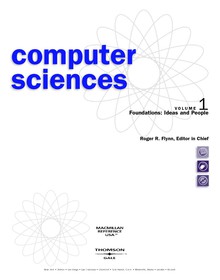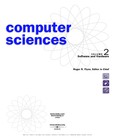Computer Sciences Volume 1
Foundations- Ideas and People

Book Details:
| Publisher: | Macmillan Science Library |
| Series: | MIX , Foundations |
| Author: | Roger R. Flynn |
| Edition: | 1 |
| ISBN-10: | 0028655672 |
| ISBN-13: | 9780028655673 |
| Pages: | 290 |
| Published: | Jun 01 2002 |
| Posted: | Nov 19 2014 |
| Language: | English |
| Book format: | |
| Book size: | 7.36 MB |
Book Description:
Volume 1 discusses the foundations of computer science, including computing history and some important innovators. Among the peope are American inventor Herman Hollerith (1860-1929), the designer of punched card and punched card equipment; English mathematician Charles Babbage (1791-1871), the inventor of the Difference Engine and the proposed Analytical Engine, a precursor of the stored program computer; English noblewoman Ada Byron King, the Countess of Lovelace (1815-1852), the first "computer programmer"; American executive Thomas J. Watson Sr. (1874-1956), early chief on the IBM Corporation; and American mathematician Grace Hopper (1906-1992), who helped in the development of COBOL (COmmon Business Oriented Language) and developed one of its predecessors, FLOW-MATIC, and is the person who allegedly coined the term "computer bug". Within Volume 1, various groups and organizations are discussed. There include the Association for Computing Machinery (ACM), which brings together people from around the globe to excahnge ideas and advance computer science; the Institute of Electrical and Electroni Engineers (IEEE), which serves as the world's largest technical professional association, with more than 350000 members; and the IBM Corporation, Apple Computer Inc., and the Microsoft Corporation, which all contributed to the start of the personal computer (PC) revolution. Among the more general articles the reader will find those concerning topics such as earlly pioneers, featuring primarily American and European scientists and their work; language generations, focusing on the evolution of computer languages; and computer generations, discussing early machines such as the ENIAC (Electronic Numerical Integrator and Computer) and the EDVAC (Electronic discrete Variable Automatic Computer). Finally, other articles of general interest in Volune 1 concern the history and workings of supercomputers; the development of the mouse; the question of computer security; the beginnings of the Internet; and the basics of digital and analog computing. The goverment's role is explained in articles on the U.S. Census Bureau and funding research projects. In addition, mathematical tools such as the binary number system and the slice rule as well as innovations such as France's Minitel are also featured.
Download Link:
Related Books:
Computer Sciences Volume 2
Software and Hardware
Volume 2 describes software and hardware. Articles cover topics from system analysis and design, which is the cornerstone of building a system, to operating systems, compiler, and parallel processing, which discuss some of the technical aspects of computing. Telecommunication subjects range from network design to wireless technology to ATM transmission, while application-oriented articles include pattern recongnition, personal digital assistants (PDAs), and computer music. Essays concerning software products include object-oriented languages, client/server technology, invasive programs, and programming. Among the people featured in Volume 2 are John Bardeen (1908-1991), Walter H. Brattain (1902-1987), and William B. Shockley (1910-1989), inventors of...
Computer Sciences Volume 3
Social Applications
In volume 3, the emphasis is on social applications. From fashion design to meteorology, the use of computers impacts our everyday lives. For example, computer technology has greatly influenced the study of biology, molecular biology, physics, and mathematics, not to mention the large role in plays in air traffic management and aircraft flight control, ATM machines and magnetic stripe cards for shopping and business. Businesses, large and small, have significantly benefited from applications that track product growth, costs, and the way products are managed. Volume 3 essays also explore the computer's role in medical image analysis and legal systems, while our use of computers in everyday life and our means of interacting with them are addressed in s...
Computer Sciences Volume 4
Electronic Universe
Volume 4 delves into our interconnected, networked society. The Internet is explored in detail, including its history, applications, and backbone. Molecular computing and artificial life are discussed, as are mobile computing and encryption technology. The reader will find articles on electronic banking, books, commerce, publishing, as well as information access and overload. Ethical matters pertaining to the electronic universe are also addressed. Volume 4 extends our aesthetic interest with articles on photography and the use of computers in art. Readers will learn more about how cybercafes keep friends and family connected as well as the type of social impact that computers have had on society. Data gathering, storage, and retrieval are investigat...
2007 - 2021 © eBooks-IT.org



